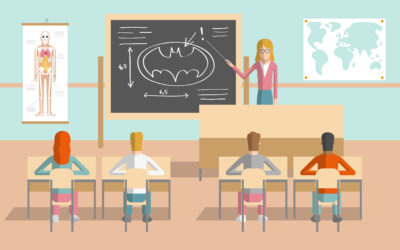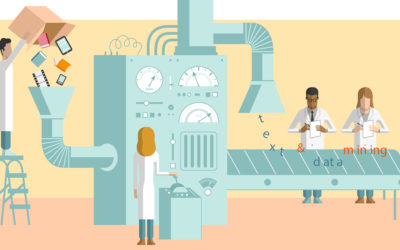Research & Private Study
Author: Stavroula Karapapa
Illustration: Davide Bonazzi
Students and researchers often need to make use of materials which are copyright protected. In the context of their research or study, they may have to make copies or use extracts of those materials. These activities are at first glance prohibited by copyright law. However, copyright allows making single copies or taking short extracts of works when the use is made for non-commercial research or for private study. The purpose is to provide students and researchers broader access to copyright works.
The exception for research and private study applies to all types of copyright work, and to recordings of performances of works. Importantly, it cannot be overridden by contract. This means that any term of a contract will be unenforceable to the extent that it tries to prevent or restrict copying that is permitted under the exception.
However, fair dealing for research and private study is allowed only if:
1) The purpose of the use is non-commercial research and/or private study
2) The use of the materials is fair
3) The use is made by researchers or students for their own use only
4) Researchers give credit to the copyright holder
The criteria are explained in detail below.
1. The purpose of the use should be non-commercial research and/or private study
Note that research and private study refer to two different kinds of activities. Research includes work that is done by an individual either for the benefit of an organisation or for the promotion of knowledge in general. It often entails a public character in the sense that research may be published. By contrast, private study is made for the individual’s own benefit and it can be part of the pursuit of a formal qualification. The distinction between research and private study is important as fair dealing for non-commercial research is also accompanied with a requirement that the source of the materials is sufficiently acknowledged.
The exception covers only non-commercial research. This is to be understood as research that is not made for profit either directly or indirectly and, hence, commercial researchers are not covered by the exception.
Special rules apply with regards to computer programs. It is not fair dealing to observe, study or test the functioning of a computer program in order to determine the ideas and principles which underlie any element of the program. This activity may be permitted when it takes place while performing the acts of loading, displaying, running, transmitting, or storing the program which the user is entitled to do. It is also not fair dealing to ‘decompile’ a computer program. This activity is only permitted to the extent that it is essential in obtaining information that is necessary to create a new interoperable program.
2. The use of the materials should be fair
There is no legal definition of what is fair or unfair; it is at the court’s discretion based on the individual facts of the case and the purpose for which the material is being used (see: ‘Legal language’ below).
Important factors in assessing whether a particular use is fair or not include: the amount and substantiality of the portion taken; the purpose and character of the use; and whether the work is published or unpublished. If a substantial part is taken, or the purpose of the use is to compete with the other work, or if the work is unpublished, then the use is unlikely to be fair.
When thinking about whether your use is fair, consider if your use of the copyright material would commercially compete with the copyright owner’s exploitation of the material. Are you really using copyright material for non-commercial research or private study, or are you pursuing another purpose? In general, your use of someone else’s work should not conflict with the way in which they normally exploit their work.
Whether your use has any financial impact on the copyright owner will often depend on the amount of their work that you are copying. Consider how much copyright material you have used and its importance. A substantial amount of the material can be used provided it is not excessive and only what is needed for research and study. This issue was discussed in Universities UK Ltd v Copyright Licensing Agency Ltd [2002] E.M.L.R. 35, at § 34. It was found for instance that ‘a student who takes a photocopy for the purposes of his course of a relevant article, or a relevant short passage from a book is likely to do so in circumstances which amount to fair dealing. At the other extreme, if he were to take a photocopy of a whole textbook, we think that his dealing would not be fair, even if done for the purposes of private study’.
3. The use is made by researchers or students for their own use only
The copyright exception is personal and can be invoked as a defence against allegations for infringement only by researchers and students, or by people making copies on their behalf.
For example, a librarian can make a copy of material under the exception if they are satisfied that the person requesting the copy requires it for research or private study, and so long as that person is not provided with more than one article from the same journal or with more than a reasonable proportion of any other published work. Also, the librarian should be careful to make sure that no one is provided with more than one copy of the same material.
Other people acting on behalf of the librarian can also make copies for a researcher or a student, but the exception does not permit making multiple copies for third parties. So, where a person knows or has reason to believe that copies of substantially the same material will be provided to more than one person at substantially the same time, and for substantially the same purpose, they cannot rely on the exception.
Lecturers, for instance, cannot rely on this exception to supply copies of the same journal article to all the students in their class. This was affirmed by a decision of the courts in which it was found that ‘[m]aterials provided by the staff for distribution to a number of students at more or less the same time would not in general amount to fair dealing’. The court continued: ‘If a lecturer were to instruct every member of his class to make copies of the same material, we consider that this too would not be fair dealing. But the mere distribution of a reading list, without any instructions to copy, is not in our view an infringement of copyright at all.’
Universities UK Ltd v Copyright Licensing Agency Ltd [2002] E.M.L.R. 35, at § 35.
4. Researchers ought to give credit to the author
This condition applies only to using work for non-commercial research.
You must include an acknowledgement to identify the creator of the work and the title of the material. It is the author who should be identified and not the owner of the copyright.
This requirement does not always have to be observed. You do not need to include an acknowledgement if it is impossible for reasons of practicality. For instance, certain works may be published anonymously or it may be impossible to ascertain the identity of the author. In this case, you need to demonstrate that you have made reasonable efforts to identify the author.
Legal language:
This is a quote taken from a legal case, where the judge explains what is fair when considering the amount of material used for research or private study.
Forensic Telecommunications Services Ltd v Chief Constable of West Yorkshire [2011] EWHC 2892 (Ch), at § 111
‘Relevant factors to be taken into account in judging whether the dealing was fair have been identified in various cases. None is determinative and the weight to be attached to them will vary from case to case. In particular, the various factors will carry different weight according to the type of dealing. Cases of fair dealing for purposes of criticism, review and the reporting of current events usually raise more difficult problems than cases of non-commercial research and private study. The three most important factors have been identified to be: (Ashdown v Telegraph Group Ltd [2001] EWCA Civ 1142; [2002] R.P.C. 5; [2002] E.C.D.R. 32)
(1) The degree to which the alleged infringing use competes with exploitation of the copyright work by the owner. This is likely to be a most important factor…
(2) Whether the work has been published or not…
(3) The extent of the use and the importance of what has been taken. In many cases this will be a highly important factor…’
Legal references:
The law on research and private study in the United Kingdom is found in Section 29 of the Copyright Designs and Patent Act 1988, which you can read here:
http://www.legislation.gov.uk/ukpga/1988/48/section/29
The changes to section 29 made by the Copyright and Rights in Performances (Research, Education, Libraries and Archives) Regulations 2014 are available here:
http://www.legislation.gov.uk/uksi/2014/1372/regulation/3/made
Related
Education
The use of materials protected by copyright is essential to the learning process. Educational resources exist in all formats that are recognised as ‘works’ in copyright law.
Libraries
This guide is aimed at the wide range of staff working in libraries and information services. Copyright exceptions apply equally to all staff working in libraries including library or information assistants.
Text & Data Mining
The electronic analysis of large amounts of copyright works allows researchers to discover patterns, trends and other useful information that cannot be detected through usual ‘human’ reading. This process, known as ‘text and data mining’…











